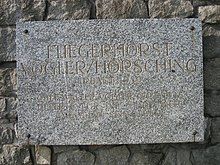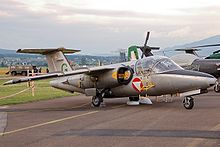Vogler Air Base
| Vogler Air Base | ||
|---|---|---|
|
|
||
| Characteristics | ||
| ICAO code | LOXL | |
| Coordinates | ||
| Height above MSL | 298 m (978 ft ) | |
| Transport links | ||
| Distance from the city center | 12 km southwest of Linz | |
| Street | B133, A1 motorway, A7 motorway | |
| Local transport | bus | |
| Basic data | ||
| opening | 1955 | |
| surface | 376 ha | |
| Terminals | 1 | |
| Runways | ||
| 08/26 | 3000 m × 60 m asphalt | |
| 08/26 (helicopter runway) | 15 m × 15 m asphalt | |
The airbase Vogler is an airbase the air forces the Austrian army in Hörsching at Linz in Austria top on which the military command Upper Austria and the command air support are stationed (ex. Air regiment 3).
location
The air base shares the runway with Linz Airport , whose facilities are north of the runway, while the air base is south.
The historical parts of the air base are under monument protection .
history
Establishment and World War II
The air base was built by the German Air Force during the Second World War . The groundbreaking ceremony took place on 13 March 1938 immediately after the connection of Austria to the German Reich. A fighter pilot school was to be built in a heathland .
Occupation of the unfinished air base began as early as 1940. About 1,000 flight personnel were trained. A total of around 3,000 men are said to have been stationed here. In the course of the war, the training airfield also became an operational airfield, and German fighter associations took off from Hörsching against the Allied bomber squadrons.
The following table shows a list of selected active flying units (excluding school and supplementary units) of the Wehrmacht Air Force that were stationed here between 1938 and 1945.
| From | To | unit | equipment |
|---|---|---|---|
| March 1938 | April 1938 | 1./JG 135 (1st squadron of Jagdgeschwader 135) | Messerschmitt Bf 109B |
| November 1941 | February 1942 | KGr. zbV 300 (combat group for special use 300) | Junkers Ju 52 / 3m |
| October 1943 | November 1943 | I./KG 51 | Messerschmitt Me 410A |
| November 1943 | March 1944 | III./KG 76 ( III.Group of Kampfgeschwader 76) | Junkers Ju 88A-4 |
| October 1944 | April 1945 | Stab, II./KG(J) 27 | Messerschmitt Bf 109K-4 |
| April 1945 | May 1945 | II./JG 52 | Messerschmitt Bf 109G |
The last take-offs of the Luftwaffe took place in early May 1945. On May 5, 1945, the 65th US Infantry Division occupied the air base.
Occupation time
The Americans named the air base Camp McCauley . However, they mainly used the barracks at the air base for US Army units and the airfield only a little.
Even before the end of the occupation , the air base was used as a training facility for the B gendarmerie .
Republic of Austria
After the establishment of the armed forces in 1956, Austrian air troops immediately moved into the air base. A hall that dates back to the wartime was already used by the civil airfield .
The flight operation was with aircraft of the type 1957 Yakovlev Yak-11 and helicopters of the type Bell 47 was added to G2. In mid-1958 the first helicopter squadron was ready for action. In 1962 the runway was renewed and lengthened so that the flying buoy ( Saab J29 Tunnan ) could be relocated here from the Burstyn barracks in Zwölfaxing . In 1964 the two military and civilian airfields were put into operation separately.
On May 25, 1967, the facility, previously known as Hörsching Air Base, was named after Lieutenant Walter Vogler, who was a military pilot in the army of the First Republic. On June 15, 1935, Vogler enabled two crew members to jump out of a burning bomber, while he himself accepted his death in order to pilot the aircraft out of the urban area of Wels .
Incidents
- On January 9, 1973, a Saab 105 OE (GH-18) crashed a few meters from the air base's runway and went up in flames. The two pilots, Captain Leopold Hoffmann and Lieutenant Hans Georg Hartl, perished. Squadron commander Hoffmann was considered by flight experts to be the best aviator in the army at the time.
- On May 14, 1977 a Saab 105 OE (GC-13) crashed on approach to the air base and was destroyed; The pilot, Captain Johann Gölzner, was killed.
Current usage
The Air Support Command (formerly 3rd Air Regiment) is the largest unit at Vogler Air Base. This is subordinate to two helicopter squadrons (with Agusta Bell 212 ), a jet squadron (with Saab 105 OE ), an air transport squadron (with C-130 Hercules ) and other units that are necessary for the administrative, supply and flight operations handling of ongoing operations. The stationing of the C-130 Hercules began in 2003, with two aircraft in that year and a third aircraft of this type being relocated to Hörsching in February 2004.
Habitat for rare birds
Species such as skylark , lapwing , partridge , curlew and quail breed on the site . These birds either no longer occur in the area or breed at a significantly lower density. The extensification of meadow use also led to the settlement or re-settlement of numerous species. With around 20 lapwing territories, the second largest lapwing colony in Upper Austria is located on the airfield. The curlew is on the site with nine breeding pairs. In addition to the extensive use of meadows, the reduced enemy pressure through predators plays a role. This is due to the fact that ground predators like the red fox cannot access the mostly fenced-in area and flying predators like carrion crows have no stand waiting due to the lack of trees and bushes. The airfield also attracts numerous birds as a resting area. The Wels airfield, ten kilometers away , is even more important as a habitat for bird species and other species.
view
|
Settlement area between Linz Airport , the Traun River and the city of Traun (aerial view, northeast towards Linz / Traun downhill)
larger settlement units from the left: at the Hörsching airport ; Air base settlement / new building on the B1 (center left) ; Aufeld / Oedt to the Traunauen (center right) ; Traun down town Traun (top right) ; on the other bank of the Traun Hasenufer (below) and opposite Traun Haid (community Ansfelden) |
See also
Web links
- Austrian Tigers Vogler Air Base
- 28. Hörsching, airport. In: Geschichtsorte , doris.ooe.gv.at (pdf, to the map layer in the DORIS map viewer; 140 kB).
Individual evidence
- ↑ Henry L. deZeng IV: Air Force Airfields 1938-45 Austria (1937 Borders) , accessed on September 4th, 2014
- ↑ http://www.tigerstaffel.at/de/?p=150
- ^ Hans Uhl: Of species-rich airfields and impoverished cultural landscape. In: ÖKO.L magazine for ecology, nature and environmental protection. Volume 35, Issue 3, Linz 2013, pp. 20–35 ( PDF on ZOBODAT ).









